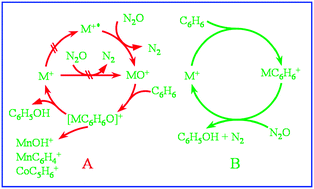Theoretical investigation of the gas-phase Mn+- and Co+-catalyzed oxidation of benzene by N2O†
Abstract
The gas-phase Mn+- and Co+-mediated oxidation of

* Corresponding authors
a
College of Physics Science and Technology, China University of Petroleum, Dongying, Shandong, PR China
E-mail:
wyguo@hdpu.edu.cn
Fax: +86 (0)546 839 2123
Tel: +86 (0)546 839 6319
b
College of Chemistry and Chemical Engineering, China University of Petroleum, Dongying, Shandong, PR China
E-mail:
shanhh@hdpu.edu.cn
The gas-phase Mn+- and Co+-mediated oxidation of

 Please wait while we load your content...
Something went wrong. Try again?
Please wait while we load your content...
Something went wrong. Try again?
L. Zhao, Z. Liu, W. Guo, L. Zhang, F. Zhang, H. Zhu and H. Shan, Phys. Chem. Chem. Phys., 2009, 11, 4219 DOI: 10.1039/B901019J
To request permission to reproduce material from this article, please go to the Copyright Clearance Center request page.
If you are an author contributing to an RSC publication, you do not need to request permission provided correct acknowledgement is given.
If you are the author of this article, you do not need to request permission to reproduce figures and diagrams provided correct acknowledgement is given. If you want to reproduce the whole article in a third-party publication (excluding your thesis/dissertation for which permission is not required) please go to the Copyright Clearance Center request page.
Read more about how to correctly acknowledge RSC content.
 Fetching data from CrossRef.
Fetching data from CrossRef.
This may take some time to load.
Loading related content
